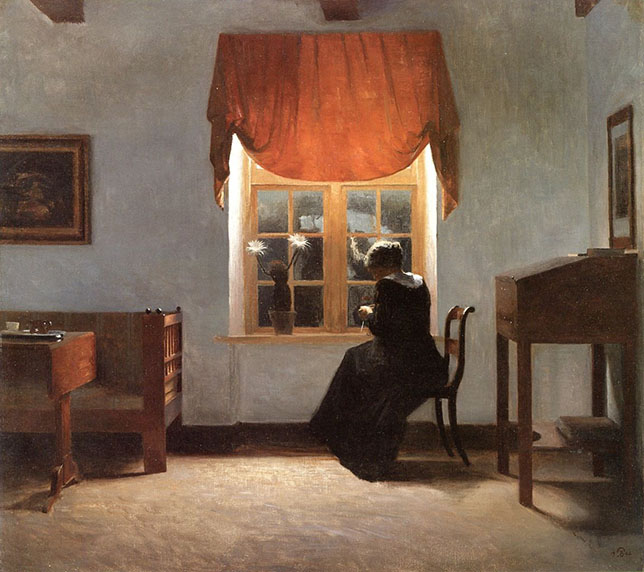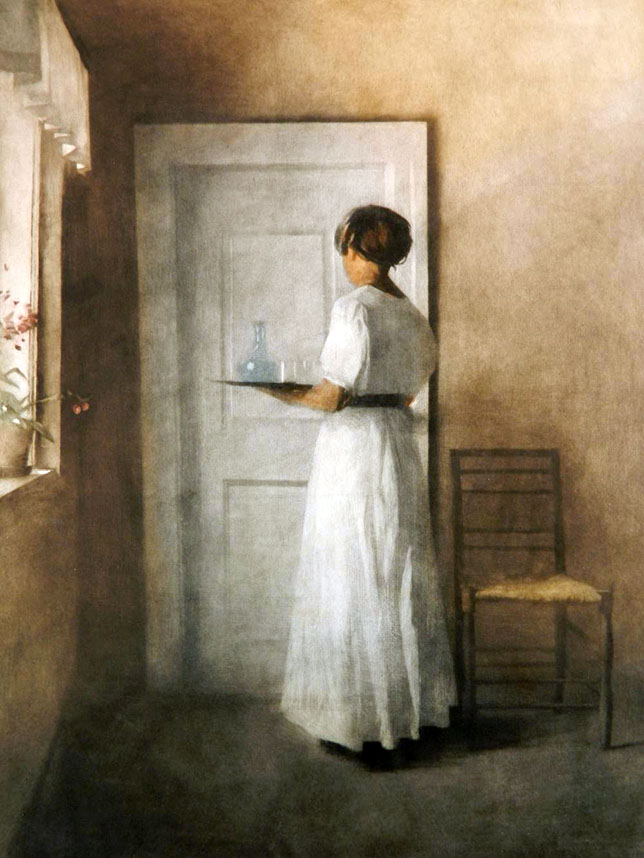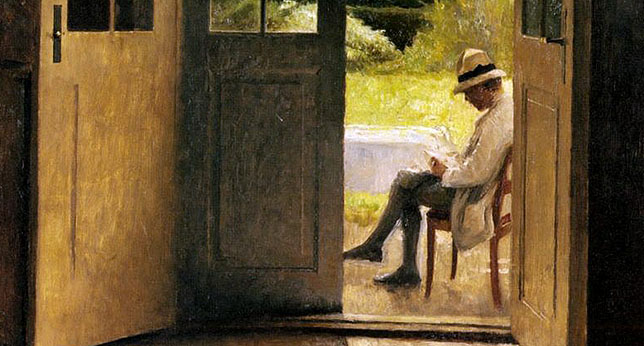Peter Ilsted came to the Royal Danish Academy of Fine Arts in 1878, completing his course of study in five years. He made his debut at the Charlottenborg Spring Exhibition in 1883. Two years later, he joined a study trip across Italy to Egypt, Palestine, Greece and Turkey. Later he visited Scotland, England, Holland, Belgium, Spain, Morocco and France. With support from the Cultural Ministry, he traveled to the Exposition Universelle (1889) in Paris. He was awarded the Eckersberg Medal in 1890 and 1899. He became an assistant at the Royal Danish Academy from 1893–1905 and worked periodically as a conservator-restorer. Ilsted died in Copenhagen during 1933.
Peter Ilsted and Vilhelm Hammershøi, together with Carl Holsøe (1863–1935), were leading artists in early 20th-century Denmark. All three artists were members of the Free Exhibitions (Den Frie Udstilling), a progressive artists association founded in 1891. They are famous for painting images of "Sunshine and Silent Rooms", all in subtle colors. Their works reflect the orderliness of a tranquil life — similar to the earlier works of Vermeer. Their art was later referred to as the ‘Copenhagen Interior School’. These interiors evoke at once a sense of calm and mystery. The orderly rooms are often viewed from behind—causing one to wonder whether the scenes are really tranquil. James McNeill Whistler, Duret and important art critics were early admirers and collectors of Ilsted’s works.
While at first glance their work appears similar, Ilsted and Hammershøi were in fact quite different. Hammershøi’s work has an aloof austerity, in contrast to Ilsted's scenes of common life. Though sometimes Hammershøi’s colorful early pictures are reminiscent of James Tissot (1836–1902), his work is quintessentially Danish. However, Ilsted was more of a technician, and he made considerable contributions in the field of graphic arts. Ilsted’s mezzotints were very popular and important in his day. They were an innovation in the media. Ilsted exhibited his work all over Europe, in London in 1907, in Germany and at the Paris Salon, where Europe’s art community was first exposed to his work.
Ilsted was a great success in his lifetime and won many awards and accolades for his work. He was the only member of the group to also focus on printmaking. Ilsted’s achievements in mezzotints were revolutionary. Some of his mezzotints, most of which were created in black as well as color editions, are considered among the greatest ever made. His greatest contribution, which T. F. Šimon (187-1942), Manuel Robbe (1872- 1936), and others seemingly adopted was that of inking the plate à la poupée. Some art historians have argued that these three men created the technique at about the same time but without consultation. This is uncertain.
The Metropolitan Museum of Art (New York) held an important exhibition on the work of Ilsted, Hammershøi, and Vermeer in 2001.
© 2020. All content on this blog is protected by international copyright laws All images are copyrighted © by Peter Ilsted or assignee. Apart from fair dealing for the purpose of private study, research, criticism or review as permitted under the Copyright Act, the use of any image from this site is prohibited unless prior written permission is obtained. All images used for illustrative purposes only
 |
| Self-Portrait with a Cigarettte |
 |
| Ved klaveret" (At the piano) 1876-98 |
 |
| Woman Sewing by the Window 1886 |
 |
| The Dining Room 1887 |
 |
| A Street Scene in Tunisia 1891 |
 |
| A Young Girl Preparing Chantarelles 1892 |
 |
| Mother and child in an interior 1898 |
 |
| Two Girls in a Doorway 1898 |
 |
| A Rainy Day 1900 |
 |
| Interior with two girls 1900 |
 |
| A Woman Knitting by a Window 1902 |
 |
| Interior with a samovar 1902 |
 |
| After School 1904 |
 |
| Interior with a lady at a spinet, evening light 1904 |
 |
| Interior with White Chair 1907 |
 |
| Woman reading 1907 |
 |
| Looking Out The Window 1908 |
 |
| A Sunlit Interior 1909 |
 |
| Young girl at a semicircular table 1909 |
 |
| Girl Sewing 1910 |
 |
| The Open Door 1910 |
 |
| Interior With Girl Reading 1910 |
 |
| Interior 1911 |
 |
| Playing mandoline 1911 |
 |
| Interior with a red shawl 1913 |
 |
| Morning Sunshine 1913 |
 |
| Girl with Tray 1915 |
 |
| The Red Room 1915 |
 |
| The Dining Room at Liselund 1917 |
 |
| Garden, Villa d'Este 1923 |
 |
| Gate in a Wood 1930 |
 |
| En Regnvejrsdag (Rainy Day) 1931 |
 |
| Fisherman's Room in Hornbaek 1932 |
 |
| At the Window n.d. |
 |
| Dried Flowers and Under Wine Leaves n.d. |
 |
| Interior from Liselund with the artist's daughters reading n.d. |
 |
| Interior with a Woman in front of Mirror n.d. |

No comments:
Post a Comment